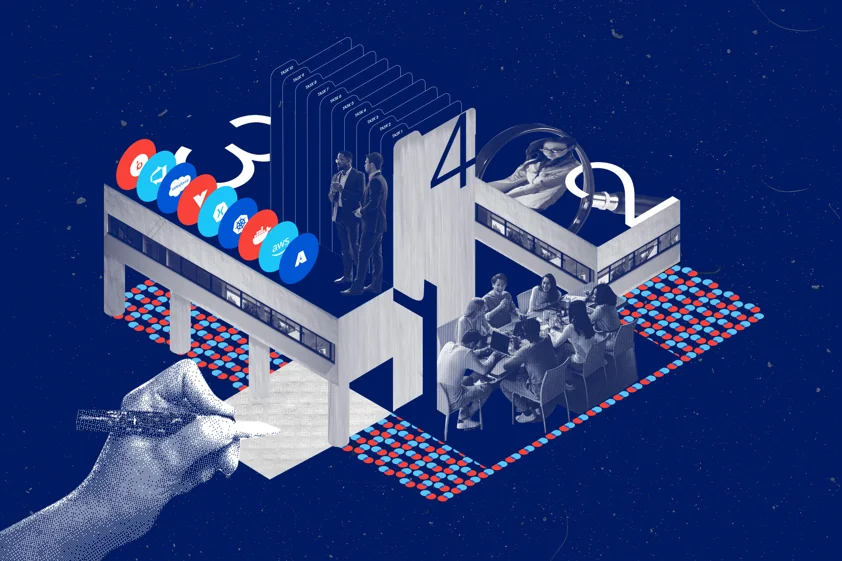To launch a 5-star app, success conditions must be created: this implies a robust plan that accompanies the well-thought-out solution.
More Precisely Defining the Solution
Developing custom digital solutions is to software design what an architect’s house is to home building.
Indeed, as soon as the first discussions, our partners entrust us with their idea, their known needs, their business goals, their timeline, and their budget, and they wish to get a 5-star app in return – and that’s what we also want to offer. To achieve this result, the project design’s first phases are crucial. Just like an architect can’t build a manor from a scribble on a napkin, we must also first elaborate a plan before getting into the digital solution’s design.
This plan allows us to align every part and to identify constraints and risks. The plan will likely save time and costs, as well as ensure the product’s viability. We are all eager to have the product in hand, but this important investment deserves adequate preparation.
A Napkin as a Starting Point to Sketch a Plan Together
Contrary to what one might think, it isn’t mandatory that the partner have an already made-up idea for the solution to implement before starting the project. In fact, a few key activities carried out during the project’s pre-design phase enable us to outline a clearer product vision:
- Kick-off meeting;
- Research;
- Tech environment review;
- Budget estimate and realization calendar draft.
Depending on our partner’s specific needs, other services might be added to the key activities list, according to the project’s scope. Whether it is analyzing the business context, defining the client pathway, studying the best practices, etc., we will choose the most appropriate activities associated with the project’s degree of uncertainty.
A better definition of a project has many advantages, but the main benefits are that it allows us to reduce ambiguity, to mitigate risks at the right time, and, especially, to get a more refined estimate in terms of scope, timeline, and budget. Indeed, when we are still in the ideation and planning phase, we can still make mistakes and adjustments without having to rebuild everything, except the hypothesis.
The Four Key Steps in the Pre-Design Phase
Step 1: Kick-Off Meeting
The kick-off is a structured meeting in the form of a workshop that groups the main stakeholders, as well as the different specialties and perspectives. From the nventive team, we will find the solutions manager, the solutions architect, and the digital strategist. We will establish basic logistics and we will ask a series of questions that enable us to better identify business goals and processes, needs, target users, constraints, and hypothesis.
Opening dialogue in this fashion allows us to better understand the context in which the product will be launched and its raison d’être. By reuniting different points of view and specialties right from the start, we get the stakeholders’ approval, which greatly facilitates the project’s subsequent steps.
Step 2: Research
By understanding the circumstances in which the product will be launched, by getting information on best practices and market trends, and by analyzing similar experiences and what the competitors are doing, our user experience strategists and researchers team captures the elements that will enrich the solution and ensure its relevance.
These activities – with a varying level or intensity depending on the solution type and the targeted users – inform us on several aspects of the project. They contribute to defining the product vision and the requirements, while also enabling us to adjust business goals and performance potential. These activities also contribute to the product design, the market entry, and change management by exposing operational elements to modify, for example.

Step 3: Tech Environment Review
Early in the pre-design process, the solutions architect joins the team. His or her contribution is essential to defining the solution by painting a picture of the existing tech environment and of the necessary tech to put the digital solution in place.
To do so, there is a knowledge-sharing process between nventive’s architect and our partner’s experts. The objective is to understand and map out the interactive flow between the different systems.
Reviewing the tech environment enables us to refine the project’s scope in terms of back-end and front-end development, as well as to ensure the solution’s performance once it is deployed. In the medium term, having control over all the systems’ interactions allows for opportunities to arise that enable product and user experience improvements.
Step 4: Budget Estimate and Realization Calendar Draft
Once the kick-off, research, and tech environment review steps are complete, we can see a more precise view of the solution and the necessary work to create it.
At this stage, the product vision is often represented by a roadmap before it is declined in a series of requirements. These requirements describe all the features in the form of user needs (backlog). This last deliverable is the digital project’s cornerstone. It’s what allows the design team to give life to the experience, and what enables the development team to materialize it.
At the end of this pre-design phase, the project’s three main aspects, namely the scope, timeline, and budget, are much more detailed. Our partner has a tangible project plan in hand, and we can provide a more realistic project estimate.
An Investment That Reduces Risks and Increases Certainty
Pre-designing can be perceived as an unnecessary phase of a project, or something we can skip if we already know what digital solution we want. Arguments to avoid this step vary:
- Part of the planning has already been done internally;
- The business plan doesn’t include this step;
- The solution is already thought-out;
- This step will delay project completion and the digital solution must quickly be out online.
The pre-design phase can indeed be a hard investment to justify to some stakeholders.
Although it might be very possible to start developing without a pre-design phase, this approach will rarely be ideal, and this compromise will bring a load of subsequent challenges.
If we come back to our analogy of an architect’s house, we must remember that building a house requires very clear plans. During the digital solution’s development, we have a little more wiggle room, especially when using the Agile method. On the other hand, a minimum of pre-design remains essential, particularly in the case of a new product, in which case we risk stumbling upon multiple back-and-forth conversations and validations in the process to fix unresolved ambiguities.
The obstacles faced during the realization phase can cause more complex and costly delays and errors than if we reveal them upfront. As we mentioned earlier: deconstructing ideas is a lot easier than having to rewrite code or worse, having to change the user’s perception.
To launch a 5-star app, success conditions must be created: this implies a robust plan that accompanies the well-thought-out solution.






